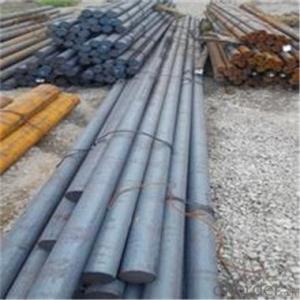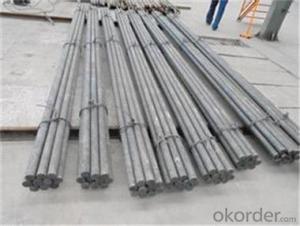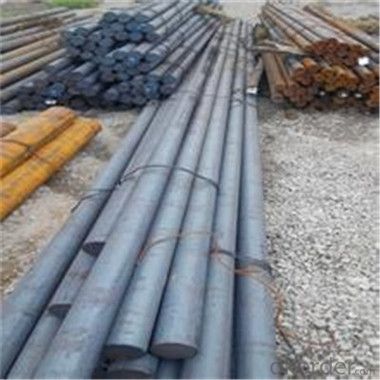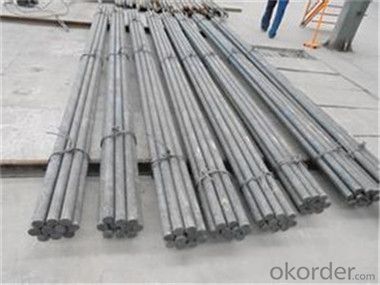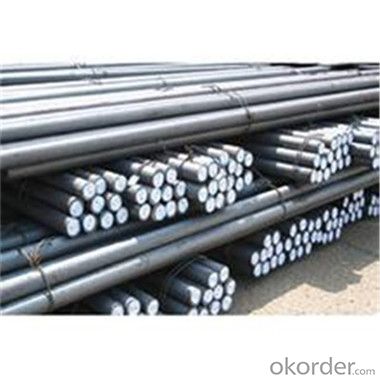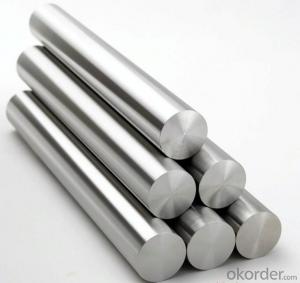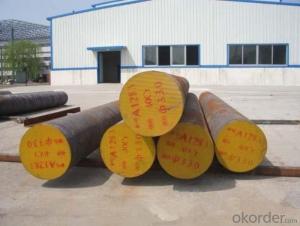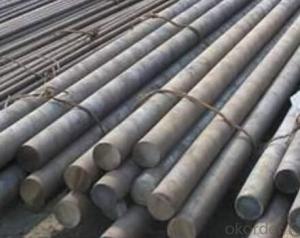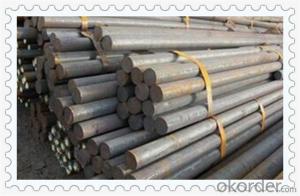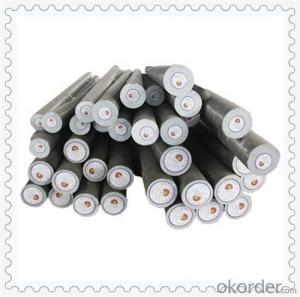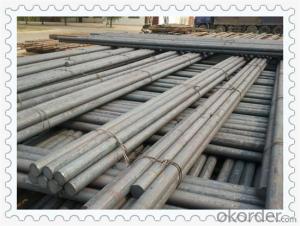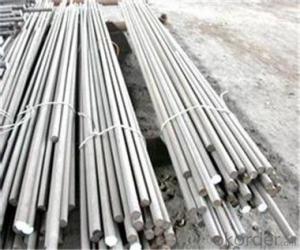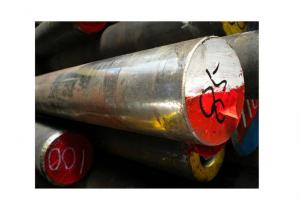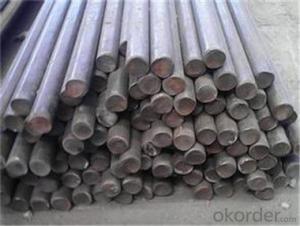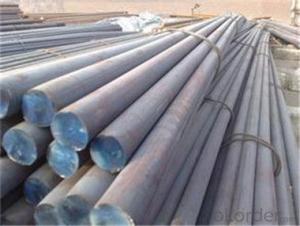Round Bar Manufacturer with Standard SKD11 High Quality
- Loading Port:
- Tianjin
- Payment Terms:
- TT OR LC
- Min Order Qty:
- 100 m.t.
- Supply Capability:
- 2000000 m.t./month
OKorder Service Pledge
OKorder Financial Service
You Might Also Like
Specification
Description of steel round bar:
(1) Thickness of not more than 2MM sheet, efficient blanking die, punch die and pressure die etc(2) All kinds of scissors, inserts, woodworking blade.
(3) Thread rolling die and wear-resistant slider.
(4) Cold Heading Die, thermosetting resin molding.
(5) Molding in deep drawing cold extrusion dies
Festures of steel round bar:
Mainly used for engineering component, forging industries, foundation bolt, shafting etc
We also stock RINL make rounds from 16mm to 80mm in all the available grades
We also take special orders in EN8, EN9 or any other equivalent grade with specific dimensional requirementsThe data given above in chart are indicative. Actual results may vary.
Specifications of steel round bar:
Description | steel round bar | |
Material | ASTM /AISI | 0,1065,1070,1080,1084 |
DIN | 5,1.7220,1.7218,1.7016,1.6523 | |
Standard | ,A575,BS970,DIN1652,JIS G4051 | |
cross section | Round Other shape:square | |
Surface | Black, galvanized,grinded,varnished,bare | |
Specifications | Round bar | Diameter: 12mm~650mm |
Angle bar | Size: 3mm*20mm*20mm | |
Square/ bar | Size: 4mm*4mm | |
Flat bar | Thickness: 2mm~100mm | |
Width:10mm~500mm | ||
Hexagonal | Size: 4mm~800mm | |
Length | Standard 6m,9m,12m or as required. | |
Trade terms | Payment terms | T/T,L/C,Western Union,negotiable etc. |
Price terms | FOB,CIF,CFR,EXW etc. | |
Applications | Hot rolled Steel round bars have a slightly grain textured finish. | |
Images of steel round bar:
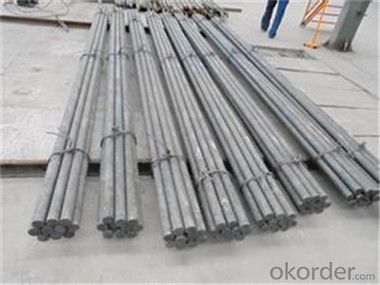
FAQ:
1. What is your package?
Packing situation: standard seaworthy packing or as customer required.
2. How long is the lead time?
Delivery time: 45 days after order confirmed.
3. What payment term do you accept?
Payment: T/T or L/C at sight.
- Q: How are steel round bars used in the manufacturing of valves and fittings?
- Valve and fitting manufacturing commonly utilizes steel round bars for their strength, durability, and versatility. These bars serve as the primary raw material for various valve and fitting components. A significant application of steel round bars in valve manufacturing involves producing valve stems. Valve stems control fluid or gas flow through the valve. The round bars are machined and threaded to create the stem, which connects to the valve disc or plug. Steel round bars are chosen for this purpose due to their high tensile strength, ensuring the stem can withstand the required pressure and torque to operate the valve. In fittings manufacturing, steel round bars are frequently used to produce threaded connectors, nipples, and couplings. These components are integral for joining pipes or tubes, enabling fluid or gas transfer in different systems. Steel round bars are easily machinable, allowing manufacturers to create precise threads and shapes necessary for these fittings. Additionally, steel round bars are also employed in fabricating the body or housing of valves and fittings. The bars can be cut, forged, or machined into the desired shape, providing a robust and dependable structure for the valve or fitting. The use of steel in the body guarantees the component's ability to endure high pressures, temperature fluctuations, and corrosive environments. In conclusion, steel round bars have a crucial role in valve and fitting manufacturing. Their strength, durability, and machinability make them an exceptional choice for creating vital components like valve stems, threaded connectors, and the bodies of valves and fittings.
- Q: Can steel round bars be used in the production of bearings?
- It is not possible to use steel round bars in the production of bearings. Bearings necessitate particular materials capable of enduring heavy loads and providing minimal friction. Steel round bars lack the essential attributes required to meet these criteria. Instead, bearings are typically manufactured from specialized materials such as chrome steel, stainless steel, or ceramics. These materials exhibit exceptional durability and performance, even in the challenging conditions under which bearings function.
- Q: What are steel round bars?
- Made from steel, steel round bars are long, cylindrical metal bars that find applications in various industries such as construction, manufacturing, and engineering. Renowned for their strength, durability, and versatility, these bars are produced through a hot rolling process. This involves heating a solid steel billet and passing it through a series of rollers to achieve the desired shape and size. Available in a range of sizes and grades, steel round bars possess different properties depending on their specific application. They serve as structural components in buildings, shafts in machinery, support bars in concrete structures, and raw material for the production of other steel products. The construction and manufacturing sectors widely prefer steel round bars due to their high tensile strength and corrosion resistance.
- Q: What are the different types of steel round bar finishes?
- There are several different types of steel round bar finishes available, each with its own unique properties and benefits. Some common types of steel round bar finishes include: 1. Hot Rolled: This finish is achieved by heating the steel to a high temperature and then rolling it while it is still hot. Hot rolled steel round bars have a rough surface and a blue-grey color. This finish is commonly used for structural applications where aesthetics are not a priority. 2. Cold Rolled: In contrast to hot rolled steel, cold rolled steel round bars are processed at room temperature. This results in a smoother surface and tighter dimensional tolerances. Cold rolled steel round bars are often used in applications that require a more polished look or where precise measurements are essential. 3. Turned and Polished: This finish involves removing the outer layer of the steel round bar through a process called turning. After turning, the bar is polished to achieve a smooth and shiny surface. Turned and polished steel round bars are commonly used in decorative applications or where a high-quality appearance is desired. 4. Ground: Ground steel round bars undergo a grinding process to remove imperfections and achieve a smooth, uniform surface. This finish is often used when tight tolerances and precise measurements are required, such as in machine parts or tools. 5. Chrome Plated: Chrome plating involves applying a layer of chromium onto the surface of the steel round bar. This finish provides enhanced corrosion resistance and a lustrous appearance. Chrome plated steel round bars are frequently used in applications where the material will be exposed to moisture or harsh environments. 6. Galvanized: Galvanizing is the process of coating steel with a layer of zinc to protect it from corrosion. Galvanized steel round bars have a characteristic silver appearance and are commonly used in outdoor applications or environments where rust is a concern. These are just a few examples of the different types of steel round bar finishes available. The choice of finish will depend on the specific requirements of the application, such as aesthetics, corrosion resistance, or dimensional tolerances.
- Q: Are steel round bars suitable for automotive applications?
- Yes, steel round bars are suitable for automotive applications. Steel round bars are commonly used in the manufacturing of various automotive components due to their high strength, durability, and resistance to corrosion. They are used in applications such as axles, crankshafts, drive shafts, steering components, suspension systems, and chassis construction. Steel round bars provide the necessary strength and rigidity required to handle the demanding conditions of automotive use, including heavy loads, vibrations, and impact forces. Additionally, steel round bars can be easily machined, welded, and forged, making them versatile and adaptable to different automotive designs and requirements. Overall, steel round bars are a reliable and cost-effective choice for automotive applications.
- Q: Can steel round bars be coated for improved aesthetics?
- Yes, steel round bars can be coated for improved aesthetics. Coating steel round bars can enhance their appearance by providing a more polished and visually appealing surface. There are various coating options available, such as powder coating, electroplating, or painting, which can be applied to steel round bars to achieve different aesthetic effects. These coatings not only enhance the appearance of the bars but also provide additional benefits such as corrosion resistance and durability. Therefore, coating steel round bars is a common practice to improve their aesthetics in various applications including architectural, decorative, and industrial purposes.
- Q: Can steel round bars be used for making fasteners or bolts?
- Yes, steel round bars can be used for making fasteners or bolts. Steel round bars are often used as raw materials for manufacturing fasteners and bolts due to their high strength, durability, and resistance to deformation. They can be shaped, threaded, and heat-treated to meet the specific requirements of fasteners and bolts.
- Q: Are steel round bars suitable for bicycle frame applications?
- Yes, steel round bars are suitable for bicycle frame applications. Steel is a popular material choice for bicycle frames due to its strength, durability, and versatility. Steel round bars provide excellent structural integrity, making them ideal for supporting the weight and stress placed on a bicycle frame during use. Additionally, steel is known for its high fatigue resistance, which means it can withstand repeated loading and unloading without losing its strength. Steel round bars also offer good weldability, allowing for easy construction and repair of bicycle frames. Overall, steel round bars are a reliable and practical choice for bicycle frame applications.
- Q: What are the different types of steel round bar finishes for decorative purposes?
- There are several different types of steel round bar finishes that are commonly used for decorative purposes. These finishes can enhance the aesthetic appeal and overall look of the steel round bar, making it suitable for various decorative applications. Some of the most popular finishes include: 1. Polished Finish: This is a smooth and shiny finish achieved by polishing the steel round bar using abrasives. It gives a reflective, mirror-like surface that adds a touch of elegance and sophistication to any decorative project. 2. Brushed Finish: Also known as satin finish, this type of finish is achieved by brushing the steel round bar with a fine abrasive material, creating a textured pattern. It provides a slightly matte appearance, making it suitable for contemporary or industrial-style decorative applications. 3. Hammered Finish: This finish involves striking the steel round bar with a hammer, creating a textured and hammered surface. It gives a rustic and aged appearance, making it ideal for decorative items with a vintage or antique-inspired theme. 4. Blackened Finish: This finish is achieved by applying a chemical or heat treatment to the steel round bar, resulting in a darkened or blackened appearance. It adds a sleek and modern touch to decorative projects, making it a popular choice for contemporary designs. 5. Powder Coated Finish: Powder coating is a durable and long-lasting finish where a powdered paint is electrostatically applied to the steel round bar and then cured under heat. This finish allows for a wide range of color options and provides excellent protection against corrosion, making it suitable for both indoor and outdoor decorative applications. These are just a few examples of the different types of steel round bar finishes that can be used for decorative purposes. Choosing the right finish depends on the desired aesthetic, style, and overall theme of the decorative project.
- Q: What are the different standards for steel round bars?
- There are several different standards for steel round bars, including ASTM A36, ASTM A105, ASTM A276, ASTM A479, and ASTM A572. These standards outline the specific requirements for the chemical composition, mechanical properties, and dimensions of steel round bars for various applications.
Send your message to us
Round Bar Manufacturer with Standard SKD11 High Quality
- Loading Port:
- Tianjin
- Payment Terms:
- TT OR LC
- Min Order Qty:
- 100 m.t.
- Supply Capability:
- 2000000 m.t./month
OKorder Service Pledge
OKorder Financial Service
Similar products
Hot products
Hot Searches
Related keywords
